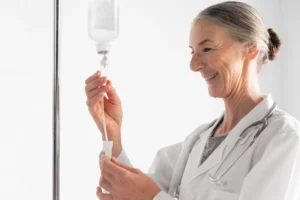In the open-label trial Can exposure-based CBT extend the effects of intravenous ketamine in obsessive-compulsive disorder? by Rodriguez et al. (2016), researchers investigated whether cognitive behavioral therapy (CBT) could prolong the rapid symptom relief provided by ketamine in patients with obsessive-compulsive disorder (OCD). This study offers preliminary but promising insights into combining pharmacological and psychological treatments to optimize therapeutic outcomes in treatment-resistant OCD.
OCD is a chronic psychiatric disorder marked by intrusive thoughts and repetitive behaviors, often resistant to standard interventions. While ketamine has demonstrated fast-acting reductions in obsessive symptoms, these effects are typically short-lived. The potential synergy between ketamine’s neurobiological action and CBT’s behavioral strategies may represent a meaningful step forward in durable OCD treatment.
Study Design and Methodology
The trial enrolled 10 unmedicated patients with moderate to severe OCD. Participants received a single intravenous (IV) ketamine infusion and were assessed for changes in obsession severity using the OCD Visual Analog Scale (OCD-VAS). Following ketamine administration, participants engaged in a brief course of exposure-based CBT, with symptom follow-up conducted up to two weeks post-infusion.
Nine of the ten participants completed the ketamine infusion, and seven continued through the CBT component. This design, although open-label and without a control group, aimed to explore real-world therapeutic trajectories when pharmacologic and behavioral modalities are used in tandem.
Key Findings: Rapid Reduction and Potential Maintenance
- Eight of nine patients reported a rapid decrease in obsessive severity post-ketamine.
- Seven patients maintained this reduction for up to 230 minutes after infusion.
- After two weeks of CBT, some individuals continued to show improvement, suggesting that behavioral therapy may help sustain the initial ketamine response.
These results build on earlier studies showing ketamine’s effectiveness in acute OCD symptom relief and extend the discussion into the realm of treatment continuity through CBT.
Clinical Implications
The findings suggest a dual-intervention pathway for OCD:
- Ketamine provides a rapid symptom relief window, potentially opening patients to better engagement with CBT.
- CBT may then reinforce and extend the effects of ketamine by leveraging neuroplastic changes and facilitating extinction learning.
This approach is especially relevant for individuals with treatment-resistant OCD, where traditional serotonin reuptake inhibitors (SRIs) have failed to provide adequate relief.
Limitations and Future Directions
As an open-label trial, this study lacks a control group and is subject to bias, including placebo effects and observer expectancy. The sample size is small, and generalizability is limited. Nevertheless, the observed clinical response justifies further investigation.
Future studies should involve:
- Randomized controlled trials (RCTs) to isolate ketamine and CBT contributions.
- Longer follow-up periods to assess the durability of response.
- Neurobiological measures to understand underlying mechanisms of synergy between ketamine and CBT.
Conclusion
The study Can exposure-based CBT extend the effects of intravenous ketamine in obsessive-compulsive disorder? underscores a novel therapeutic strategy: pairing rapid-acting pharmacotherapy with structured behavioral therapy to achieve both immediate and lasting benefits. While preliminary, these findings highlight the potential of integrative treatment models for challenging psychiatric conditions like OCD.
References
- Rodriguez CI, Wheaton M, Zwerling J, et al. Can exposure-based CBT extend the effects of intravenous ketamine in obsessive-compulsive disorder? An open-label trial. J Clin Psychiatry. 2016;77(3):408-409. https://doi.org/10.4088/JCP.15l10138
- Bloch MH, Green C, Kichuk SA, et al. Systematic review and meta-analysis of the efficacy of exposure and response prevention therapy for obsessive-compulsive disorder. J Clin Psychiatry. 2013;74(6):e542–e550.
- Song J, Korgaonkar MS, Armstrong G, et al. Ketamine treatment for depression: A review. Neurosci Biobehav Rev. 2022;132:134–149. https://doi.org/10.1016/j.neubiorev.2021.10.028
- Taylor SF, Liberzon I. Neural correlates of emotion regulation in PTSD: A meta-analysis of neuroimaging studies. Am J Psychiatry. 2007;164(9):1476–1488.
- Ressler KJ, Mayberg HS. Targeting abnormal neural circuits in mood and anxiety disorders: From the laboratory to the clinic. Nat Neurosci. 2007;10(9):1116–1124.




